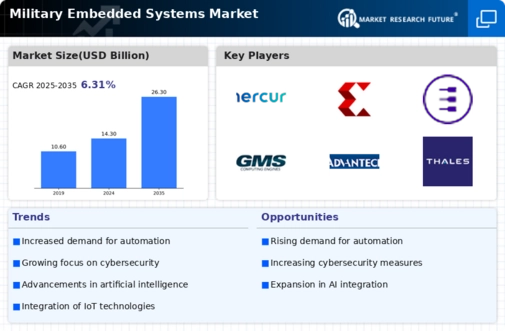Top Industry Leaders in the Military Embedded Systems Market

Strategies Adopted:
Product Differentiation: Key players focus on developing innovative military embedded systems with enhanced performance, reliability, and scalability to meet evolving defense requirements, thus gaining a competitive edge in the market.
Strategic Partnerships: Collaboration with technology providers, research institutions, and defense agencies enables companies to access advanced technologies, expand their product portfolios, and offer integrated solutions addressing complex defense challenges.
Market Expansion: Companies adopt strategies to penetrate emerging markets and regions with high defense expenditure, such as Asia-Pacific and the Middle East, by establishing local partnerships, subsidiaries, and production facilities to capitalize on growth opportunities.
Focus on Cybersecurity: With increasing cybersecurity threats, key players prioritize the integration of robust cybersecurity features into military embedded systems to ensure data integrity, confidentiality, and availability, thus enhancing market competitiveness.
Key Companies in the military embedded systems market include
Curtiss-Wright Corporation (US)
KONTRON AG (Germany)
Mercury Systems Inc. (US)
Xilinx Inc. (US)
EUROTECH (Italy)
General Dynamics Corporation (US)
General Micro Systems Inc. (US)
Advantech Co. Ltd. (Taiwan)
Thales Group (France)
SMART Embedded Computing (US)
Factors for Market Share Analysis:
Technology Leadership: Market share analysis considers the technological capabilities and innovation prowess of key players, with companies offering cutting-edge embedded computing solutions and advanced sensor integration commanding a larger market share.
Product Portfolio: The breadth and depth of product portfolios, including ruggedized computers, mission computers, and avionics systems, influence market share, with companies offering comprehensive solutions meeting diverse defense applications gaining a competitive advantage.
Customer Relationships: Strong relationships with defense primes, government agencies, and system integrators, built on reliability, performance, and after-sales support, contribute to market share by fostering loyalty and repeat business.
Global Presence: The global footprint, including regional offices, manufacturing facilities, and distribution networks, enhances market share by enabling companies to serve customers efficiently and effectively across different geographies.
Industry News:
Advancements in AI and Machine Learning: Industry news highlights advancements in artificial intelligence (AI) and machine learning (ML) algorithms integrated into military embedded systems to enable autonomous decision-making, real-time analytics, and predictive maintenance capabilities.
Contract Awards: News of contract awards and procurement programs by defense agencies and OEMs signify market leadership and drive market growth for key players, providing opportunities for new entrants and emerging companies.
Focus on C4ISR Integration: Increasing focus on command, control, communications, computers, intelligence, surveillance, and reconnaissance (C4ISR) integration drives demand for military embedded systems capable of interoperability, data fusion, and multi-domain operations.
Investments in Cybersecurity: Rising cybersecurity threats necessitate investments in secure embedded computing solutions, driving industry collaborations, standards development, and technology advancements to address evolving cyber threats and vulnerabilities.
Current Company Investment Trends:
R&D Investments: Key players continue to invest in research and development to enhance the performance, reliability, and security of military embedded systems, focusing on technologies such as AI, ML, cybersecurity, and edge computing to meet future defense requirements.
Mergers and Acquisitions: Companies pursue strategic mergers and acquisitions to strengthen their market position, expand their product portfolios, and gain access to complementary technologies and capabilities, driving consolidation and market consolidation in the military embedded systems market.
Technology Partnerships: Collaborations with technology providers, startups, and research institutions enable companies to access emerging technologies, accelerate innovation, and develop next-generation military embedded computing solutions to maintain competitiveness.
Sustainability Initiatives: Increasing focus on sustainability initiatives, including energy-efficient designs, eco-friendly materials, and lifecycle management programs, aligns with customer demands for environmentally responsible solutions and regulatory requirements, driving market differentiation and brand value.
Military Embedded Systems Industry Developments
For instance,
April 2021
Science Applications SAIC earned a $2.9 billion contract to continue assisting the US Army with its mission engineering capabilities. The award has a performance period of five years. According to the deal, the company will continue to develop advanced technologies and assist the United States Army in developing, integrating, and maintaining software platforms.
For instance,
April 2020
Abaco Systems presented their new 3U CompactPCI Robust Single Board Computer, designed for various demanding applications in the defense, aerospace, industrial, and commercial sectors where rugged reliability in hostile environments is vital. The size, weight, and power consumption of the IMP3B CompactPCI is all small (SWaP). CompactPCI's market share in military embedded systems has increased due to the new 3U CompactPCI boards.




